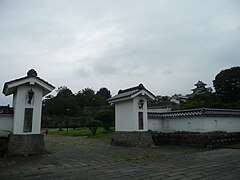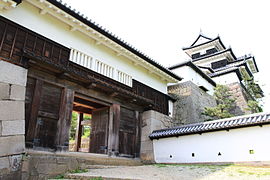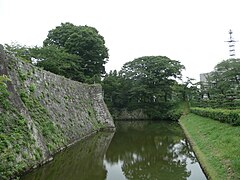Shirakawa-Komine Castle
| Shirakawa-Komine Castle | ||
|---|---|---|
|
Shirakawa Komine |
||
| Alternative name (s): | Shirakawa Castle, Komine Castle |
|
| Creation time : | before 1560 | |
| Castle type : | Hirayamajiro (hill castle) | |
| Conservation status: | Partly reconstructed | |
| Place: | Shirakawa | |
| Geographical location | 37 ° 7 '57.4 " N , 140 ° 12' 48.9" E | |
|
|
||
The Shirakawa-Komine Castle ( Japanese 白河 小 峰 城 , Shirakawa-Komine-jō ), also simply Komine Castle ( 小 峰 城 , Komine-jō ), and the traces of the Shirakawa Castle ( 白河 城 , Shirakawa-jō ) are located in the Shirakawa City , Fukushima Prefecture . In the Edo period , eight medium-sized daimyo resided at Komine Castle one after the other , most recently the Abe with an income of 100,000 koku .
Lords of the castle in the Edo period
- From 1590 the Kamō.
- From 1627 a branch of the Niwa with 100,000 koku.
- From 1643 the Sakakibara with 140,000 Koku.
- From 1649 a branch of the Honda with 120,000 Koku.
- From 1681 a branch of the Matsudaira (Okudaira) with 150,000 koku.
- From 1692 a branch of the Matsudaira (Kamon) with 150,000 koku.
- From 1741 a branch of the Matsudaira (Hisamatsu) with 110,000 koku.
- From 1823 a branch of the Abe with 100,000 Koku.
The attachment
The Shirakawa-Komine Castle was built by a branch line of the Shirakawa-Yūki ( 白 川 結 城 ), namely the Komine ( 小 峰 ). It was Komine Yoshichika ( 小 峰 義 親 ; approx. 1500–1559) who took up residence in the castle. Through Toyotomi Hideyoshi , the area came to Aizu-Wakamatsu in 1590. From then on the lords of the castle were the Kamō ( 蒲 生 ), Uesugi ( 上杉 ), again the Kamō, until 1627 Niwa Nagashige ( 丹羽 長 重 ; 1571–1637) by shogunate order from Tanakura ( Mutsu Province ) there with an income of 100.00 Koku and founded the Shirakawa-Han. Nagashige carried out a major renovation on orders from the Shogunate in 1629, which was only completed after four years of painstaking work. The Niwa were followed by the daimyo listed above, most recently the Abe, who held the castle until 1868.
The castle lies with its central area, the Hommaru, on a small hill, called Komine-ga-oka ( 小 峰 ヶ 岡 ), south of the Abukuma River ( 阿 武 隈 川 ). The current course of the river is the result of a diversion made by the Niwa. To the south of the central area was the castle district Ni-no-maru, further south the district of San-no-maru. There were also the castle areas Take-no-maru ( 竹 ノ 丸 ) and Obiguruwa district ( 帯 曲 輪 ). Each area was protected by a moat, the inner areas were also protected by stone walls.
To protect the Hommaru there was a three-story watchtower in the northeast, which was used as a keep , at the northwest corner the two-story Yukimi watchtower ( 雪見 櫓 , Yukimi-yagura ), in the southwest the Fujimi watchtower ( 富士 見 櫓 , Fujimi -yagura ). A total of six watchtowers protected the castle. All structures went up in flames in the Boshin War .
Part of the castle area, Hommaru and Ni-no-maru, is now the city park. In 1991 the three-story watchtower in Hommaru and in 1994 the main gate next to it was rebuilt.
photos
literature
- Mizoguchi, Yasutsune: Shirakawa-Komine-jo in: Miura, Masayuki (Ed.): Shiro to jinya. Tokoku-hen. Gakken, 2006. ISBN 978-4-05-604378-5 , p. 100.
- Miyaji, Saichiro (Ed.): Bakumatsu shoshu saigo-no hanshu-tachi. Higashinihon-hen. Jinbunsha, 1997. ISBN 978-4-7959-1905-1 .






